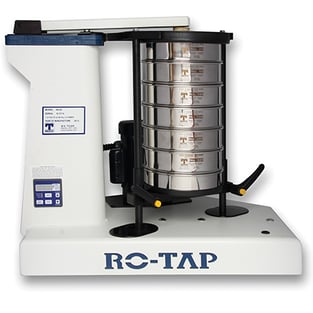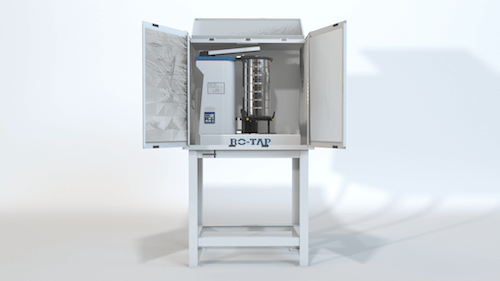Using the RO-TAP® RX-29: Preventative Maintenance
Since its creation in 1914, the RO-TAP® product line has become synonymous with accurate and repeatable test sieve analysis results. The W.S. Tyler RO-TAP RX-29, in particular, has even been written into dozens of industry standards as the gold standard.
But the RX-29 employs a lot of moving parts to deliver the trusted results you've come to expect. Naturally, these parts are bound to endure wear and tear over time.
As allowing worn parts to go unaddressed for too long can have a negative impact on your sieve analysis results, you must incorporate a preventive maintenance schedule into your routine.
As founder of the original RO-TAP Sieve Shaker, W.S. Tyler is particularly passionate about helping you achieve a level of operational efficiency that you feel confident in.
That's why we wrote the following article highlighting some ways you can keep your device running longer. The article will cover:
- What the RO-TAP RX-29 is
- The common mistakes you should avoid when operating the RO-TAP RX-29
- The key indicators that something is wrong with your RO-TAP RX-29
- The preventive maintenance routine you should implement into your process
What Is a RO-TAP RX-29?

The RO-TAP RX-29 is W.S. Tyler's signature mechanical sieve shaker to test particles 635 mesh (20 micron) to 2". It employs an oscillating motion that works in conjunction with brute force hammer taps to promote particle movement throughout a test sieve stack.
The stack can consist of either 13 half-height or six full-height 8-inch test sieves.
What Are the Common Mistakes Made When Using the RO-TAP RX-29?
One of the biggest mistakes lab technics make is neglecting to do regular spot checks of their device. As a result, minor, easy-to-address issues go unnoticed until it's too late and something fails.
It is also common for users to plug the device into an outlet that does not match the device's voltage. This may cause your RO-TAP device to operate erratically and wear down the moving parts quicker.
Another form of user error that isn't uncommon is getting the device wet. Over-exposure to moisture that exceeds a damp cloth to clean the device can affect the electrical components of the device.
Again, this can cause irregular operation, which may result in accelerating part wear and tear.
What Are Common Issues That Indicate Something Is Wrong With Your RO-TAP RX-29 Device?
A key indicator that you should check the moving parts of your RO-TAP RX-29 device is if it begins to operate louder than its typical 78 dB. When the different parts become worn, they have a tendency to move irregularly when testing material.
This causes the entire device to move more than it usually does which subsequently causes louder operation.
Additionally, as the inconsistent movements become more prominent, your sample material doesn't move as fluently through the test sieve stack. In other words, if you have worn out parts and things are moving the way they are supposed to be, your sieve analysis results will be off.
What Preventive Maintenance Should I Include in My Process?
 To prevent costly downtime, you should set aside time to conduct preventive maintenance monthly.
To prevent costly downtime, you should set aside time to conduct preventive maintenance monthly.
A significant step of your preventive maintenance routine should be checking the various brass parts. This includes the two eccentric discs and the bushing that the lift rods go through.
With the movement of the machine, the brass parts will wear down over time. As they begin to get loose, they fail to properly direct the device motions. This can eventually lead to more substance repairs.
You should also be mindful of the state of the device's timing belt and cam gear.
The timing belt is rubber and may dry out or wear over time. It is essential to check for cracking or overly worn spots.
The cam gear works with the time belt pulley and has nylon teeth. You should check to ensure all the teeth are still intact, which can be done by flipping the device on its side.
It should be noted that the brass bushings previously mentioned are oil-impregnated. That said, if these were to ever need to be lubricated, you could apply WD-40.
Of course, you will also want to keep the device clean of any debris.
An In-depth Guide To Replacing RO-TAP Parts
The RO-TAP RX-29 is a mechanical sieve shaker that uses several moving parts to conduct a reliable test sieve analysis. Preventative measures such as checking the various brass parts, timing belt, cam gear, and power source should be taken to combat the risk of prolonged downtime.
These tips are simply meant to extend the life of the moving parts of the RO-TAP RX-29, but they will eventually need to be replaced. When a part needs to be replaced, it's important that you know exactly what to do to get back to testing material as quickly as possible.
W.S. Tyler introduced the original RO-TAP mechanical sieve shaker over 100 years ago, and it's important to us that you fill supported throughout your entire RO-TAP journey. To help you maintain a reliable test sieve analysis operation, we will leverage our years of experience to help your device last for years to come.
Below is a blog post that we created to deliver both written and video content that serves as a step-by-step guide to changing the most commonly replaced RO-TAP RX-29 parts, including the those listed above:
About Ronnie Brown
Ronnie is the Content Writer for W.S. Tyler and has four years of experience as a professional writer. He strives to expand his knowledge on all things particle analysis and woven wire mesh to leverage his exceptional writing and graphic design skills, creating a one-of-a-kind experience for customers.




